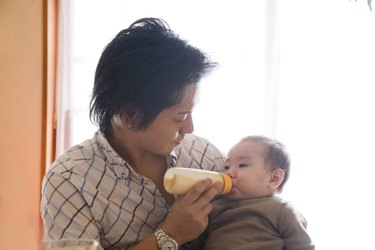
An exact amount of milk needed for a 3-month old baby is difficult to calculate. Some babies drink small amounts of milk frequently throughout the day while others may consume large quantities with more time between feedings. You can get an idea of how much milk your baby needs in a day and monitor the infant's hunger cues to determine how much to feed the baby at each meal.
Significance
Video of the Day
At 3 months, a baby is still very new to the world and his communication skills are minimal. He may be able to show a caregiver he is hungry by thrusting his tongue out of his mouth, sucking on anything he can put into his mouth or crying. A breastfeeding mother can rest assured her baby is getting enough to eat without counting the ounces. You can look for the baby to be alert, content, active, gaining weight, growing, developing, eating six to eight times a day and producing enough wet and dirty diapers in a day states Kids Health. A caregiver tracking the amount of milk an infant drinks can have more reassurance that the baby is actually hungry based on the total amount of milk consumed in a day.
Video of the Day
Identification
Identify the number of ounces of milk to feed your baby with the help of a health care professional. DrGreene.com suggests that an average baby consumes two or three ounces of milk per pound of body weight each day, up to 32 ounces. At 3 months of age, the weight of a baby varies from one infant to another. Breastfed babies who don't use a bottle will still be nursing between six and eight times per day until the three-month growth spurt occurs. After that, nursing sessions may increase for several days or longer. Kids Health states an average baby will drink between four and five ounces per feeding but at the end of the third month, she may need five to six ounces per bottle.
Considerations
At 3 months of age, an infant may start one of the many growth spurts she will go through in her first year. This can lead her to eat more milk per feeding or to demand more feedings in a day. A breastfed baby may appear to drink more or less milk than a formula-fed baby because nursing directly makes measuring impossible. Pumping or expressing breast milk and feeding it to an infant can give caregivers an accurate idea of how much milk the baby drinks in a day.
Monitoring
Caregivers cannot always be sure that feeding a baby a set amount of milk each day provides the infant with sufficient nutrition and fluids. Counting wet and dirty diapers produced in a day can assist in monitoring a baby's milk needs. At around two months, Kids Health states that a breastfed baby may no longer produce a dirty diaper after every feeding. No infant should go three days or longer between bowel movements.
Overfeeding
Setting a specific number of ounces to feed a baby per day can lead to overfeeding. DrGreene.com points out that a baby knows when to stop feeding. If a parent continues to force a bottle on the baby, it can lead to excess weight gain and spit-up. Bottles come in various sizes. Some hold 12 ounces or more. Not every baby will eat 12 ounces in one meal and this is something that need not concern a caregiver. Some infants will take four ounces of milk at every feeding for most of the first year while others may gradually increase the amount per feeding and decrease the number of feedings in a day. You can avoid overfeeding by using the recommended amount of milk as a guideline and use other cues as evidence that the baby is getting enough to eat.
Is this an emergency? If you are experiencing serious medical symptoms, please see the National Library of Medicine’s list of signs you need emergency medical attention or call 911.